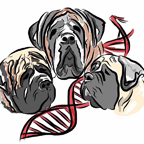
Common eye problems that affect the Mastiff breed:
- Cataract – Lens opacity that may in part or in total affect one or both eyes. Blindness results when cataracts are complete and in both eyes.
- Distichiasis – Eyelashes abnormally located in the eyelid margin which may cause ocular irritation.
- Ectropion – Conformational defect resulting in eversion of the eyelids, which may cause ocular irritation due to exposure.
- Entropic – Conformational defect where eyelid margin inverts, or rolls inward, toward the eye causing eyelashes and hair to rub against the cornea resulting in ocular irritation.
- Macromolecular – Abnormally large eyelid opening; may lead to secondary conditions associated with corneal exposure.
- Persistent Papillary Membranes (PPM) – Persistent blood vessel remnants in the anterior chamber of the eye which fail to regress normally in the neonatal period.
- Progressive Retinal Atrophy (PRA) – Degenerative disease of the retinal visual cells which leads to blindness. In Mastiffs the age at which PRA can be detected varies from as young as 6 months to as late as 42 months. Typically Mastiffs with PRA go blind gradually, first loosing their night vision and then their day vision. Many do not go completely blind until they are 8 years old or older. Click on the button below to learn more about PRA.
- Retinal Dysplasia – Abnormal development of the retina present at birth and recognized to have three forms: folds, geographic, and detachment. A Mastiff with just folds will pass CERF and the folds may disappear over time.
(CAER) Eye Testing Recommendation
The Companion Animal Eye Registry (CAER) recommends that dogs receive a CAER eye exam annually to look for eye problems in our dogs. CAER certifications are only good for 12 months from the time of the exam.
The MCOA Health Committee recommends that all Mastiffs should have their eyes examined by a Board Certified Veterinary Ophthalmologist within the 12 months prior to being bred. This should be done every year since eye conditions can show up later in life.
You can get a list of Board Certified Veterinary Ophthalmologists that are qualified and approved to do CAER exams on the American College of Veterinary Ophthalmologists (ACVO) website: http://www.acvo.org/ophthalmologist-search.
Mastiffs Assist Researchers - Mastiffs Providing Model for Human Retinitis Pigmentosa (RP)
The June 2002 issue of DVM News Magazine has an article titled “English Mastiff a model for human eye disease”. It states that the Mastiff breed is enabling scientists to help explain retinitis pigmentosa in humans. It is a joint study by Cornell Baker Institute for Animal Health and The University of Pennsylvania’s Scheie Eye Institute and was reported in the April 30, 2002 Proceedings of the National Academy of Sciences.
The Scheie Eye Institute also shared an article on their website dated April 23, 2002 titled: “Dog Discovery a Major Step in Treatment of Genetic Blindness, Similarities between Humans and Mastiffs Pose New Hope for Observation, Treatment”.
Updated: 11/12/2024